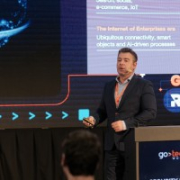

Kaspersky Endpoint Security for Business and Elastic Security are prominent in cybersecurity. Kaspersky has an edge for ease of use and support, while Elastic Security excels in advanced threat detection.
Features: Kaspersky offers antivirus, anti-malware protection, application control, and vulnerability assessment. Elastic provides threat hunting, log analysis, and proactive threat detection.
Room for Improvement: Kaspersky needs better third-party tool integration and faster scan performance. Elastic requires usability improvements and simplified configuration. Users find it complex with a steep learning curve.
Ease of Deployment and Customer Service: Kaspersky is praised for its straightforward deployment and responsive support. Elastic, although powerful, is complex to deploy, requiring more technical expertise and initial setup guidance.
Pricing and ROI: Kaspersky is cost-effective with a good ROI due to transparent pricing. Elastic, with a higher initial cost, is valued for its extensive feature set and long-term security benefits.
It does not require hefty security budgets and can be deployed for enterprise security effectively.
Providing necessary assistance efficiently.
Most of the time when my team encounters issues, they receive responses within 24 hours.
I have not faced any difficulties with Elastic Security, as we have a pretty good support service from them.
I would rate technical support from Kaspersky a nine out of ten.
The technical support from Kaspersky was very responsive.
It allows us to think about specific use cases, such as gathering malicious IPs in a single view and analyzing threats based on geolocation.
Elastic Security is quite scalable.
Both scalability and stability of Kaspersky Endpoint Security for Business are solid.
Any endpoint added to Active Directory can be detected by Kaspersky Security Center, which can then push the agent onto it.
In terms of stability, I would rate Elastic a solid eight out of ten.
There have been performance issues during scanning, causing the PC to respond slowly.
CrowdStrike and Defender have more established threat intelligence integration due to having a larger client base.
My security testing team continuously reports vulnerabilities, and we have to fix and update the versions frequently.
Machine learning algorithms become better with time; as they ingest a huge volume of data, they become better.
I previously mentioned that Kaspersky Endpoint Security for Business doesn't have built-in DLP, which was a concern.
Kaspersky needs to improve its security techniques as it has not been in Gartner records for the last two years.
The pricing is reasonable, especially for Small Medium Enterprises (SMEs), making it a viable option for businesses building their security infrastructure.
This is beneficial for SMEs as they do not need extensive budgets for security solutions.
Elastic Security is considered cost-effective, especially at lower EPS levels.
The pricing and licensing cost of Kaspersky Endpoint Security is cheaper compared to Trend Micro.
The platform provides more visibility and requires less effort in monitoring.
Elastic Security offers good insight regarding alerts, reports, and cases.
The most useful features I find in Elastic Security are the forensic ones that allow us to carry deeper analysis into the logs for in-depth investigations, and the dashboards, with the reporting dashboard being quite user-friendly.
It stands out as an antivirus and malware protection solution due to its extensive feeds and resources for antivirus signatures.
The best features in Kaspersky Endpoint Security for Business are the file threat protection, web threat protection, mail threat protection, network threat protection, firewall, behavior detection, and exploit prevention.
| Product | Market Share (%) |
|---|---|
| Kaspersky Endpoint Security for Business | 2.1% |
| Elastic Security | 2.5% |
| Other | 95.4% |


| Company Size | Count |
|---|---|
| Small Business | 40 |
| Midsize Enterprise | 11 |
| Large Enterprise | 15 |
| Company Size | Count |
|---|---|
| Small Business | 62 |
| Midsize Enterprise | 27 |
| Large Enterprise | 33 |
Elastic Security combines the features of a security information and event management (SIEM) system with endpoint protection, allowing organizations to detect, investigate, and respond to threats in real time. This unified approach helps reduce complexity and improve the efficiency of security operations.
Additional offerings and benefits:
Finally, Elastic Security benefits from a global community of users who contribute to its threat intelligence, helping to enhance its detection capabilities. This collaborative approach ensures that the solution remains on the cutting edge of cybersecurity, with up-to-date information on the latest threats and vulnerabilities.
Kaspersky Endpoint Security for Business is a cybersecurity solution that is designed to protect small and large business networks and devices from all types of cyber security threats by implementing machine learning algorithms for real-time threat detection and response. The solution offers antivirus protection, firewall, network attack protection, web control, device control, data encryption, reporting tools, and more. Kaspersky integrates with a wide variety of external systems and platforms and is easy to customize to meet your organization’s specific security needs.
Benefits of using Kaspersky Endpoint Security for Business
Some of the key benefits of using Kaspersky Endpoint Security for Business include:
Kaspersky Endpoint Security for Business features
Kaspersky Endpoint Security for Business provides its users with a wide range of features to protect their corporate networks and devices against multiple types of threats, including:
Reviews from Real Users
Kaspersky Endpoint Security for Business stands out among its competitors for a number of reasons. Several major ones are its high performance, flexibility, and powerful virtualization capabilities.
Natnael A., a consultant at IWM Network Solutions, writes, “The app virtualizing is a great feature. The system developers use it to deliver apps to targeted staff. It basically reduces the server infrastructure resource. The solution provides good functionality.”
Rob M., a systems administrator at Saint Tammany Parish Hospital, says, “The solution has provided flexibility by allowing an end user to remote in, log in, and get their VM. VDI session and have all the icons and applications they need to use and retain the same booking view regardless of location.”
We monitor all Endpoint Detection and Response (EDR) reviews to prevent fraudulent reviews and keep review quality high. We do not post reviews by company employees or direct competitors. We validate each review for authenticity via cross-reference with LinkedIn, and personal follow-up with the reviewer when necessary.